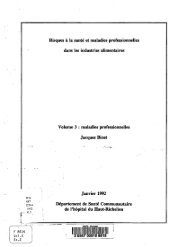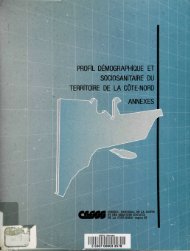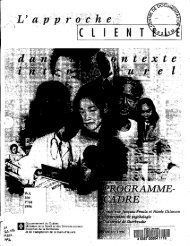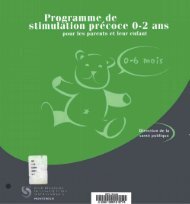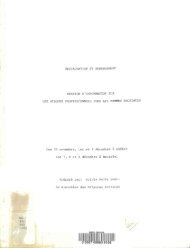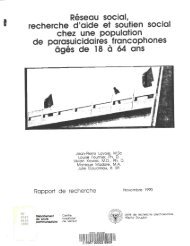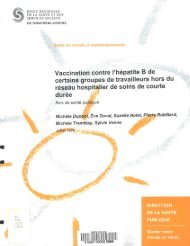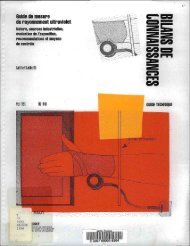le travail à l'écran de visualisation work with display units
le travail à l'écran de visualisation work with display units
le travail à l'écran de visualisation work with display units
Create successful ePaper yourself
Turn your PDF publications into a flip-book with our unique Google optimized e-Paper software.
Il 70VDT WORK RELATED FACTORS AND PREGNANCY OUTCOMES - RESEARCHHYPOTHESESUlf Bergqvist, Department of Neuromedicine, National Institute of Occupational Health, Solna,Swe<strong>de</strong>n.The question whether <strong>work</strong> <strong>with</strong> visual <strong>display</strong> terminals during pregnancy affects thepregnancy outcome has been given increased scientific attention during the last <strong>de</strong>ca<strong>de</strong>. Anumber of possib<strong>le</strong> causal factors for such an interaction have been proposed, and will bereviewed here. Evaluating the proposed factors by current scientific know<strong>le</strong>dge, two criteriacan be put forward; first, whether the factor exist in VDT <strong>work</strong> situations, and second, whetherdata suggest a potency for interaction in general <strong>with</strong> pregnancy processes. Using both thesecriteria, a number of the suggested factors can be eliminated.Remaining conten<strong>de</strong>rs for an interaction are two for which some suggestive data are availab<strong>le</strong>;viz low frequency pulsed magnetic fields and excessive stress or worry. Some other suggestedfactors exist in VDT <strong>work</strong> situations, but the suggestion for interaction potency is by and largeunsupported.The suggestion that stress and/or worry can influence the risk of miscarriage has beenrepeatedly ma<strong>de</strong> - and is supported by effects on animals and some human observations, thelatter primarily from situations of habitual abortions. Counterarguments have e g centered onspecies differences (concerning animal data) and the possibility of individual factors(concerning interpretation of habitual abortion experiences). In summary, a number ofindications but no conclusive evi<strong>de</strong>nce appear to support the stress/worry hypothesis. Inaddition, the relationship between stress/worry and VDT <strong>work</strong> is not c<strong>le</strong>ar-cut.The second conten<strong>de</strong>r, low frequency magnetic fields is more distinctly associated <strong>with</strong> VDTsbased on CRTs. The current inability to propose an acceptab<strong>le</strong> mo<strong>de</strong>l for interaction <strong>with</strong>biologic materia makes it, however, extremely difficult to evaluate fields of different temporalappearances - thus, VDT-specific issues are reviewed based on studies <strong>with</strong> magnetic fields ofthe same temporal appearance ("saw-tooth" form). Five studies have so far been ma<strong>de</strong> onvarious animal and in vitro systems, <strong>with</strong> varying and partly conflicting results. In summary,whi<strong>le</strong> some studies do indicate the possibility of an interaction, other studies have not been ab<strong>le</strong>to confirm this.A final ref<strong>le</strong>xion on the outcome of epi<strong>de</strong>miological studies in light of these two hypotheses canbe ma<strong>de</strong>: Both of these two factors exist in VDT <strong>work</strong> situations, but the <strong>de</strong>gree of variabilityacross different VDT <strong>work</strong> situations may be of interest. The major factor for variability of themagnetic field exposure is probably posture - something basically unpredictab<strong>le</strong> and pro primonot predicted by <strong>work</strong> types. This appears to be in sharp contrast <strong>with</strong> the situation concerningstress situations. Thus, it is possib<strong>le</strong> to argue that the outcome of the Kaiser Permanente study -in which different risk ratios for miscarriages were observed in different job categories - did<strong>le</strong>nd some increased credibility to the stress/worry hypothesis, but none to the magnetic fieldhypothesis.EFFECTS ON NON-IONIZING RADIATIONKjell Hansson Mild, Natl Inst Occup Health, Umeâ, Swe<strong>de</strong>n.I'l - 71The e<strong>le</strong>ctric and magnetic fields around VDTs have been surveyed byseveral investigators. There are five different types of fields present in thevicinty of the catho<strong>de</strong> ray tube based VDT: an e<strong>le</strong>ctrostatic field, ELF e<strong>le</strong>ctricand magnetic fields <strong>with</strong> the refresh rate frequency, VLF e<strong>le</strong>ctric andmagnetic field <strong>with</strong> line frequency. Measurement show that the equiva<strong>le</strong>nte<strong>le</strong>ctrostatic surface potential on the screen can reach up to 20 kV for someVDTs, and the ELF e<strong>le</strong>ctric field in front of the VDT at a distance of 0.5 mrange from some up to tens of volts per meter but most of the time it is notdistinguishab<strong>le</strong> from the office background 50 Hz e<strong>le</strong>ctric field. The ELFmagnetic field can reach a few tenths of a jiT, and close to the tube thevalues are up to some (iT. The VLF e<strong>le</strong>ctric fields range from some up to tensof volts per meter and the corresponding magnetic field is of the or<strong>de</strong>r of afew tenths of a JIT at 0.5 m in front of the VDT.The question have been raised about possib<strong>le</strong> health effects from exposureto these weak e<strong>le</strong>ctromagnetic fields in connection <strong>with</strong> <strong>work</strong> <strong>with</strong> the<strong>display</strong> terminal. It has been known for some time that weak alternatinge<strong>le</strong>ctromagnetic fields can give rise to biological effects on many organization<strong>le</strong>vels, from subcellular <strong>le</strong>vel to effects on humans. Several reports showeffects on such fundamental cellular processes as DNA synthesis, changes incell membrane properties, chromosome aberrations, changes in transcriptionpatterns. Experiments have shown that the early embryonic <strong>de</strong>velopment inchicks and mice may be affected by weak magnetic field exposure. In somestudies an altered behaviour response of the experimental animals is seenafter exposure. Weak magnetic field exposure of human volunteers havebeen shown to give a reduction in heart rate <strong>with</strong> up to 5-10 beats perminut. There are also recent epi<strong>de</strong>miological studies that suggests thatmagnetic field exposure in excess of 0.2-0.3 |iT may act as a cancerpromotor, and that fetal <strong>de</strong>velopment may be affected.It is difficult to un<strong>de</strong>rstand how such weak field can cause these effectssince the energy associated <strong>with</strong> the fields are or<strong>de</strong>rs of magnitu<strong>de</strong> belowthe thermal energy of random motion. At present there is not sufficentinformation availab<strong>le</strong> as to which factor, e<strong>le</strong>ctric or magnetic field, is themore important. Furthermore the ro<strong>le</strong> of the geomagnetic field, the ro<strong>le</strong>s offield strength, frequency, duration of exposure, intermittent versuscontinous exposure are also unknown. It is not until the question on theinteraction mechanism(s) is solved that we can answer the question onpossib<strong>le</strong> health effects from exposure to weak alternating e<strong>le</strong>ctromagneticfields. The <strong>de</strong>finition of safe and unsafe field <strong>le</strong>vels must await furtherresearch that will elucidate the interaction mechanism.KEYWORDS: e<strong>le</strong>ctric and magnetic field, non-ionizing radiation, biologica<strong>le</strong>ffects.Keywords: Stress, magnetic fields, pregnancy outcomes.TEV 1989 — DEUXIÈME CONFÉRENCE SCIENTIFIQUE INTERNATIONALE • MONTRÉAL • SECOND INTERNATIONAL SCIENTIFIC CONFERENCE — WWDU 1989TEV 1989 — DEUXIÈME CONFÉRENCE SCIENTIFIQUE INTERNATIONALE • MONTRÉAL • SECOND INTERNATIONAL SCIENTIFIC CONFERENCE — WWDU 198912586



